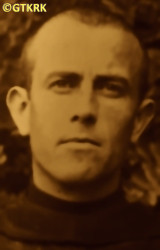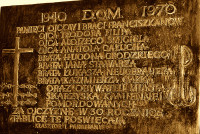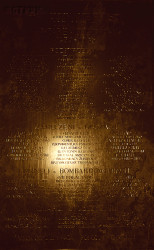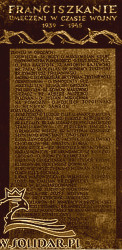Roman Catholic
St Sigismund parish
05-507 Słomczyn
85 Wiślana Str.
Konstancin deanery
Warsaw archdiocese, Poland
full list:
displayClick to display full list

searchClick to search full list by categories
wyświetlKliknij by wyświetlić pełną listę po polsku

szukajKliknij by przeszukać listę wg kategorii po polsku

Martyrology of the clergy — Poland
XX century (1914 – 1989)
personal data
surname
GRODZKI
forename(s)
Andrew (pl. Andrzej)
religious forename(s)
Hugolinus Mary (pl. Hugolin Maria)
function
laybrother
creed
Latin (Roman Catholic) Church RCmore on
en.wikipedia.org
[access: 2014.09.21]
congregation
Order of Friars Minor Conventual OFMConvmore on
en.wikipedia.org
[access: 2013.05.19]
(i.e. Conventual Franciscans)
diocese / province
Immaculate Mary province OFMConvmore on
pl.wikipedia.org
[access: 2014.08.18]
st Anthony of Padua and bl. James Strzemię province OFMConvmore on
pl.wikipedia.org
[access: 2014.08.18]
date and place
of death
14.02.1940

Bór foresttoday: Bór district in Skarżysko‐Kamienna, Skarżysko‐Kamienna urban gm., Skarżysko‐Kamienna pov., Holy Cross voiv., Poland
more on
en.wikipedia.org
[access: 2021.12.19]
details of death
After German and Russian invasion of Poland in 09.1939 and start of the World War II, after start of German occupation, collaborator of local clandestine resistance „White Eagle” organization (part of future Polish Clandestine State).
In his monastery in Skarżysko–Kamienna weaponry was hidden and clandestine meetings were held.
Arrested by the Germans, together with 3 co–friars, on 06.02.1940 (3 Congregations' fathers, including monastery's guardian, Fr Ignatius John Filip, were arrested few days earlier.
Held in public school building in Place district of Skarżysko.
On 11.02.1940 (according to other sources on 05.02.1940) sentenced by the German Germ. Standgericht (Eng. summary court) to death.
Taken to an execution site and murdered with his co‐brothers.
cause of death
mass murder
perpetrators
Germans
sites and events
Bór forestClick to display the description, GeneralgouvernementClick to display the description, «Intelligenzaktion»Click to display the description, Ribbentrop‐MolotovClick to display the description, Pius XI's encyclicalsClick to display the description
date and place
of birth
01.12.1905Birth certification on:
photos.szukajwarchiwach.gov.pl
[access: 2025.09.05]

Kobylin‐Pieniążkitoday: Kobylin‐Borzymy gm., Wysokie Mazowieckie pov., Podlaskie voiv., Poland
more on
en.wikipedia.org
[access: 2022.01.28]
parents
GRODZKI Vincent
🞲 ?, ? — 🕆 ?, ?

PISZCZATOWSKA Philomena
🞲 ?, ? — 🕆 ?, ?
baptism
03.12.1905Birth certification on:
photos.szukajwarchiwach.gov.pl
[access: 2025.09.05]

Kobylintoday: Kobylin‐Borzymy, Kobylin‐Borzymy gm., Wysokie Mazowieckie pov., Podlaskie voiv., Poland
more on
en.wikipedia.org
[access: 2022.01.28]
St Stanislav the Bishop and Martyr RC church
religious vows
06.01.1935 (temporary)
23.01.1938 (permanent)
positions held
1939 – 1940
friar — Skarżysko‐Kamiennatoday: Skarżysko‐Kamienna urban gm., Skarżysko‐Kamienna pov., Holy Cross voiv., Poland
more on
en.wikipedia.org
[access: 2021.12.19] ⋄ Immaculate Conception of the Blessed Virgin Mary monastery, Conventual Franciscans OFMConv — carpenter
1934 – 1939
friar — Niepokalanówtoday: part of Paprotnia village, Teresin gm., Sochaczew pov., Masovia voiv., Poland
more on
en.wikipedia.org
[access: 2021.10.09] ⋄ Immaculate Conception of the Blessed Virgin Mary monastery, Conventual Franciscans OFMConv — monthly magazines addressing subdivision (1938‐1939), underwear department (1937‐1938), „Little Daily”expedition department (1935‐1937), knitting department department (1935), cook (1935), underwear department (1934‐1935), stamping department (1933‐1934), nutrition department / kitchen cleaner (1933)
04.06.1933 – 1934
novitiate — Niepokalanówtoday: part of Paprotnia village, Teresin gm., Sochaczew pov., Masovia voiv., Poland
more on
en.wikipedia.org
[access: 2021.10.09] ⋄ Immaculate Conception of the Blessed Virgin Mary monastery, Conventual Franciscans OFMConv
from 08.02.1933
accession — Conventual Franciscans OFMConv
others related
in death
FILIPClick to display biography Ignatius John (Fr Theodore), GAŁEKClick to display biography Joseph (Bro. Casimir Mary), GAŁUCHAClick to display biography Anthony (Fr Anatol), NEUGEBAUERClick to display biography Felix (Bro. Luke Mary), STAWARZClick to display biography Sigismund (Bro. John Baptist), ŚMIGIELClick to display biography Joseph (Fr Louis)
sites and events
descriptions
Bór forest: In Bór forest near Skarżysko‐Kamienna on 12‐14.02.1940 Germans — officers of the genocidal organization „Die Schutzstaffel der NSDAP” (Eng. „National–socialist NSDAP party protection unit”), i.e. «SS», supported by soldiers of the German army Wehrmacht, officers of the Germ. Ordnungspolizei (Eng. Order Police), i.e. „Orpo”, and members of the German genocidal paramilitary formation Germ. Volksdeutscher Selbstschutz (Eng. German Self‐Defense), the creation of which on Polish lands occupied by German troops was decided in Berlin on 08‐10.09.1939 at a conference headed by Reichsführer‐SS Heinrich Himmler (call order of 20.09.1939), and the units emerging chaotically from among the German minority in Poland were directly subordinated to the «SS» — murdered, after bloody interrogations and torture (those imprisoned were beaten and tortured, e.g. knees were squeezed with a vice, burned with candles, etc.), c. 360 Poles. Arrests started on 29.01.1940 — crushing of Polish resistance Clandestine Military Organization „The White Eagle Association” was cited as a pretext. The real aim was however extermination of Polish intelligentsia and ruling classes in Skarżysko‐Kamienna and its vicinity. The victims were sentenced to death by the genocidal Germ. Standgericht (Eng. summary court) — the trial lasted a few minutes. The convicts were transported in groups of 5‐10 people in trucks to the execution site in a nearby forest (the journey took about 10 minutes), where they were shot over previously dug pits. The executions lasted from dawn to dusk, for a total of three days. Among the murdered were seven monks, Conventual Franciscans OFMConv. (more on: pl.wikipedia.orgClick to attempt to display webpage
[access: 2013.12.04])
Generalgouvernement: After the Polish defeat in the 09.1939 campaign, which was the result of the Ribbentrop‐Molotov Pact and constituted the first stage of World War II, and the beginning of German occupation in part of Poland (in the other, eastern part of Poland, the Russian occupation began), the Germans divided the occupied Polish territory into five main regions. In two of them new German provinces were created, two other were incorporated into other provinces. However, the fifth part was treated separately, and in a political sense it was supposed to recreate the German idea from 1915 (during World War I, after the defeat of the Russians in the Battle of Gorlice in 05.1915) of creating a Polish enclave within Germany. Illegal in the sense of international law, i.e. Hague Convention, and public law, managed by the Germans according to separate laws — especially established for the Polish Germ. Untermenschen (Eng. subhumans) — till the Russian offensive in 1945 it constituted part of the Germ. Großdeutschland (Eng. Greater Germany). Till 31.07.1940 formally called Germ. Generalgouvernement für die besetzten polnischen Gebiete (Eng. General Government for the occupied Polish lands) — later simply Germ. Generalgouvernement (Eng. General Governorate), as in the years 1915‐1918. From 07.1941, i.e. after the German attack on 22.06.1941 against the erstwhile ally, the Russians, it also included the Galicia district, i.e. the Polish pre‐war south‐eastern voivodeships. A special criminal law was enacted and applied to Poles and Jews, allowing for the arbitrary administration of the death penalty regardless of the age of the „perpetrator”, and sanctioning the use of collective responsibility. After the end of the military conflict of the World War UU, the government of the Germ. Generalgouvernement was recognized as a criminal organization, and its leader, governor Hans Frank, guilty of war crimes and crimes against humanity and executed. (more on: en.wikipedia.orgClick to attempt to display webpage
[access: 2024.12.13])
«Intelligenzaktion»: German: «Intelligenzaktion» (English: „Intelligence Action”) — a German program of extermination of the Polish elite, mainly the intelligentsia and leadership layers, carried out from the beginning of the occupation in w 09.1939 to 04.1940, mainly in territories directly annexed to Germany, but also in the so‐called Germ. Generalgouvernement (Eng. General Governorate), where it was called «AB‐aktion». In the first phase, immediately after the beginning of the German occupation, during military operations carried out by the Germ. Wehrmacht (Eng. Armed Forces) and the genocidal units of the Germ. Einsatzgruppen (Eng. Operational Groups) of the Germ. Sicherheitspolizei (Eng. Security Police), i.e. SiPo, and Germ. Sicherheitsdienst des Reichsführers SS (Eng. Security Service of the Reichsführer SS), i.e. SD, organized by the Germ. Reichssicherheitshauptamt (Eng. Reich Main Security Office), i.e. RSHA, which followed the troops, carried out under the Germ. Unternehmen „Tannenberg” (Eng. Operation „Tannenberg”) — based on the so‐called Germ. Sonderfahndungsliste (Eng. Special Wanted Lists), i.e. proscription lists of Poles considered particularly dangerous to the Third Reich, prepared by the Zentralstelle II/P (Polen) unit of the German RSHA. Later, implemented by the German civilian occupation authorities and the genocidal unit of the Germ. Volksdeutscher Selbstschutz (Eng. Ethnic Germans Self‐Defense), whose members were Germ. Volksdeutsche (Eng. Ethnic Germans), i.e. representatives of the German minority in Poland. According to various sources, these lists, at the beginning of 09.1939, could have contained the details of 61,000—88,000 „dangerous” Poles — although these figures cannot be confirmed. In total, during this genocide, c. 50,000 teachers, Catholic priests, representatives of the landed gentry, freelancers, social and political activists, and retired military personnel were systematically and methodically murdered. Another 50,000 were sent to concentration camps, where only a negligible percentage survived. (more on: en.wikipedia.orgClick to attempt to display webpage
[access: 2014.10.04])
Ribbentrop‐Molotov: Genocidal Russian‐German alliance pact between Russian leader Joseph Stalin and German leader Adolf Hitler signed on 23.08.1939 in Moscow by respective foreign ministers, Mr. Vyacheslav Molotov for Russia and Joachim von Ribbentrop for Germany. The pact sanctioned and was the direct cause of joint Russian and German invasion of Poland and the outbreak of the World War II in 09.1939. In a political sense, the pact was an attempt to restore the status quo ante before 1914, with one exception, namely the „commercial” exchange of the so‐called „Kingdom of Poland”, which in 1914 was part of the Russian Empire, fore Eastern Galicia (today's western Ukraine), in 1914 belonging to the Austro‐Hungarian Empire. Galicia, including Lviv, was to be taken over by the Russians, the „Kingdom of Poland” — under the name of the General Governorate — Germany. The resultant „war was one of the greatest calamities and dramas of humanity in history, for two atheistic and anti‐Christian ideologies — national and international socialism — rejected God and His fifth Decalogue commandment: Thou shall not kill!” (Abp Stanislav Gądecki, 01.09.2019). The decisions taken — backed up by the betrayal of the formal allies of Poland, France and Germany, which on 12.09.1939, at a joint conference in Abbeville, decided not to provide aid to attacked Poland and not to take military action against Germany (a clear breach of treaty obligations with Poland) — were on 28.09.1939 slightly altered and made more precise when a treaty on „German‐Russian boundaries and friendship” was agreed by the same murderous signatories. One of its findings was establishment of spheres of influence in Central and Eastern Europe and in consequence IV partition of Poland. In one of its secret annexes agreed, that: „the Signatories will not tolerate on its respective territories any Polish propaganda that affects the territory of the other Side. On their respective territories they will suppress all such propaganda and inform each other of the measures taken to accomplish it”. The agreements resulted in a series of meeting between two genocidal organization representing both sides — German Gestapo and Russian NKVD when coordination of efforts to exterminate Polish intelligentsia and Polish leading classes (in Germany called «Intelligenzaktion», in Russia took the form of Katyń massacres) where discussed. Resulted in deaths of hundreds of thousands of Polish intelligentsia, including thousands of priests presented here, and tens of millions of ordinary people,. The results of this Russian‐German pact lasted till 1989 and are still in evidence even today. (more on: en.wikipedia.orgClick to attempt to display webpage
[access: 2015.09.30])
Pius XI's encyclicals: Facing the creation of two totalitarian systems in Europe, which seemed to compete with each other, though there were more similarities than contradictions between them, Pope Pius XI issued in 03.1937 (within 5 days) two encyclicals. In the „Mit brennender Sorge” (Eng. „With Burning Concern”) published on 14.03.1938, condemned the national socialism prevailing in Germany. The Pope wrote: „Whoever, following the old Germanic‐pre‐Christian beliefs, puts various impersonal fate in the place of a personal God, denies the wisdom of God and Providence […], whoever exalts earthly values: race or nation, or state, or state system, representatives of state power or other fundamental values of human society, […] and makes them the highest standard of all values, including religious ones, and idolizes them, this one […] is far from true faith in God and from a worldview corresponding to such faith”. On 19.03.1937, published „Divini Redemptoris” (Eng. „Divine Redeemer”), in which criticized Russian communism, dialectical materialism and the class struggle theory. The Pope wrote: „Communism deprives man of freedom, and therefore the spiritual basis of all life norms. It deprives the human person of all his dignity and any moral support with which he could resist the onslaught of blind passions […] This is the new gospel that Bolshevik and godless communism preaches as a message of salvation and redemption of humanity”… Pius XI demanded that the established human law be subjected to the natural law of God , recommended the implementation of the ideal of a Christian state and society, and called on Catholics to resist. Two years later, National Socialist Germany and Communist Russia came together and started World War II. (more on: www.vatican.vaClick to attempt to display webpage
[access: 2023.05.28], www.vatican.vaClick to attempt to display webpage
[access: 2023.05.28])
sources
personal:
www.bj.uj.edu.plClick to attempt to display webpage
[access: 2012.11.23], tsk24.plClick to attempt to display webpage
[access: 2013.05.19], photos.szukajwarchiwach.gov.plClick to attempt to display webpage
[access: 2025.09.05]
bibliographical:
„Martyrology of the Polish Roman Catholic clergy under nazi occupation in 1939‐1945”, Victor Jacewicz, John Woś, vol. I‐V, Warsaw Theological Academy, 1977‐1981
„Biographical–bibliographical dictionary of Polish Conventual Franciscan Fathers murdered and tragically dead in 1939‐1945”, Lukas Janecki, Franciscan Fathers’ Publishing House, Niepokalanów, 2016
„A martyrology of Polish clergy under German occupation, 1939‐1945”, Fr Szołdrski Vladislaus CSSR, Rome 1965
original images:
www.skarzysko24.plClick to attempt to display webpage
[access: 2014.10.04], www.sowiniec.com.plClick to attempt to display webpage
[access: 2014.07.11]
LETTER to CUSTODIAN/ADMINISTRATOR
If you have an Email client on your communicator/computer — such as Mozilla Thunderbird, Windows Mail or Microsoft Outlook, described at WikipediaPatrz:
en.wikipedia.org, among others — try the link below, please:
LETTER to CUSTODIAN/ADMINISTRATORClick and try to call your own Email client
If however you do not run such a client or the above link is not active please send an email to the Custodian/Administrator using your account — in your customary email/correspondence engine — at the following address:

giving the following as the subject:
MARTYROLOGY: GRODZKI Andrew
To return to the biography press below:
 Click to return to biography
Click to return to biography












